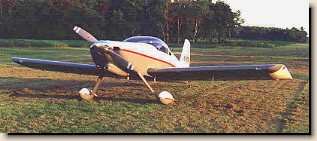Two Dead in Tragic Colonial Beach, VA Mishap
The NTSB has released it preliminary report on a 07 June 2023 accident in which an experimental, amateur-built Vans, RV-6, registration N835BC, was destroyed and its two occupants—a father and son—fatally injured shortly after departing a grass runway in the vicinity of Colonial Beach, Virginia

The accident-aircraft was operated as a personal flight under Part 91 of the Federal Aviation Regulations.
A witness and professed lifelong-friend of the decedents reported the pilot and his father had flown the accident aircraft from Wilmington, North Carolina to his home in Colonial Beach, Virginia, landing on a nearby 1,700-foot grass runway.
After a night of fishing, the witness drove father and son back to the airplane, arriving at the grass runway at approximately 09:45 EDT. The pilot reportedly stated he intended to fly to Virginia’s Tappahannock Airport (XSA) for purpose of taking on fuel before continuing to Wilmington, North Carolina.
The witness stated he returned to his home and was standing in the driveway thereof when he heard the accident-aircraft overhead. Looking on, the witness observed the RV-6 execute two 360-degree turns over his property. During the second orbit, the aircraft entered what the witness called a “very steep” or “knife-edge” attitude at an approximate altitude of one-hundred-feet AGL.
The RV-6’s nose subsequently dropped, and the aircraft impacted the ground adjacent the witness’s driveway in a nose-down vertical attitude.
The witness reported the accident-aircraft’s engine, up to the moment of impact, sounded as if it were “running well.”
A second witness—neighbor to the first, owner of the grass runway, and a former U.S. Naval aviator, aircraft owner, and 4,500-hour pilot—stated the deceased had made use of his runway on approximately six occasions over the last two-years. The second witness corroborated the account of the first, stating he’d observed the accident-aircraft make two, increasingly-tight, 360-degree turns over his neighbor’s home at an approximate but variable altitude of one-hundred-feet AGL. The second witness added, however, that the RV-6 was “not going very fast” and set forth its nose dropped successively from twenty, to eighty, to ninety-degrees in the moment preceding impact.
The accident-aircraft came to ground between the first witness’s driveway and a corn-field, impacting in a nose-down attitude and coming to rest upright on a heading of 345-degrees magnetic. A post-crash fire consumed the RV-6 almost entirely.
The wreckage was compact, containing all four corners of the airplane. The RV-6’s wood propeller fractured into several pieces which were recovered near the accident-site.

The leading-edges of both the accident-aircraft’s wings exhibited accordion crushing. The right-wing flap was separated and came to rest behind the main wreckage. The aircraft’s right aileron remained attached to the wing by its linkage. The RV-6’s left-wing flap and aileron remained attached as well. The airplane’s fuselage, instrument panel, cabin, seats, and inboard wings were consumed by fire. Fire-damage notwithstanding, the RV-6’s rudder, elevator, and vertical stabilizer remained intact.
The accident-aircraft’s engine was badly fire damaged—its accessories alternately charred and melted entirely. The engine was rotated by the propeller hub and thumb compression was observed on three of its four cylinders. Engine continuity was established via the engine and accessory case. Lighted-borescope inspection of the engine’s cylinders revealed no anomalies.
The accident, ascribed NTSB number ERA23FA260, remains under investigation.
 ANN's Daily Aero-Linx (06.29.25)
ANN's Daily Aero-Linx (06.29.25) ANN's Daily Aero-Term (06.29.25): Gross Navigation Error (GNE)
ANN's Daily Aero-Term (06.29.25): Gross Navigation Error (GNE) Classic Aero-TV: Anticipating Futurespace - Blue Origin Visits Airventure 2017
Classic Aero-TV: Anticipating Futurespace - Blue Origin Visits Airventure 2017 NTSB Final Report: Cirrus SR22
NTSB Final Report: Cirrus SR22 Airborne Affordable Flyers 06.26.25: PA18 Upgrades, Delta Force, Rhinebeck
Airborne Affordable Flyers 06.26.25: PA18 Upgrades, Delta Force, Rhinebeck




